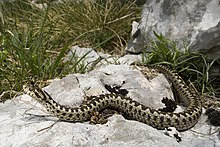Loading AI tools
Species of snake From Wikipedia, the free encyclopedia
Vipera ursinii is a species of venomous snake in the subfamily Viperinae of the family Viperidae. It is a very rare species, which is in danger of extinction. This species is commonly called the meadow viper, Ursini' s viper,[4] or meadow adder.[5] It is found in France, Italy, and Greece as well as much of eastern Europe.[6] Several subspecies are recognized.[7] Beyond the highly threatened European population, poorly known populations exist as far to the east as Kazakhstan and northwestern China.
| Vipera ursinii | |
|---|---|
 | |
| Scientific classification | |
| Domain: | Eukaryota |
| Kingdom: | Animalia |
| Phylum: | Chordata |
| Class: | Reptilia |
| Order: | Squamata |
| Suborder: | Serpentes |
| Family: | Viperidae |
| Genus: | Vipera |
| Species: | V. ursinii |
| Binomial name | |
| Vipera ursinii (Bonaparte, 1835) | |
| Synonyms[3] | |
| |
The specific name or epithet, ursinii, is in honor of Italian naturalist Antonio Orsini (1788–1870).[8][9]
Adults of V. ursini average 40–50 cm (15.75–19.69 inches) in total length (including tail), although specimens of 63–80 cm (24.8–31.5 inches) in total length have been reported.[4] Females are larger than males. Although sometimes confused with V. aspis or V. berus, it differs from them in the following characters. The smallest viper in Europe, its body is thick, its head narrow, and its appearance rough. The snout is not upturned. There are always several large scales or plates on the top of the head. The prominently keeled dorsal scales are in only 19 rows, and often dark skin shows between them. It is gray, tan, or yellowish with a dark undulating dorsal stripe, which is edged with black.[10]
Meadow viper, Ursini's viper,[4] meadow adder,[5] Orsini's viper, field viper,[11] field adder.[12] Although the following subspecies are currently invalid according to the taxonomy used here, their common names may still be encountered:
Southeastern France, eastern Austria (extinct), Hungary, central Italy, Serbia, Montenegro, Croatia, Bosnia and Herzegovina,[13] northern and northeastern Republic of Kosovo, North Macedonia, Albania, Romania, northern Bulgaria, Greece, Turkey, northwestern Iran, Armenia, Azerbaijan, Georgia, Russia and across Kazakhstan, Kyrgyzstan and eastern Uzbekistan steppes to China (Xinjiang).
Vipera ursinii rakosiensis is native to Hungary[14] although the taxonomic status of this subspecies is disputed (see section "Taxonomy")
The type locality is " ...monti dell'Abruzzo prossimi alla provincia d'Ascoli... " (...mountains of Abruzzo near the Province of Ascoli Piceno, Italy...).[3]
The species Vipera ursinii is considered to be a Vulnerable species on the IUCN Red List of Threatened Species, due to habitat destruction caused by changes in agricultural practices and climate change in mountain areas, and to collection for the pet trade.[1]
In addition, this species is listed on CITES Appendix I, which prohibits commercial international trade,[15] and is a strictly protected species (Appendix II) under the Berne Convention.[16]
V. ursinii is the most threatened snake in Europe. At least 12 human activities are threatening these animals: 1. Grazing 2. Mowing 3. Fire 4. Agriculture 5. Roads 6. Constructions 7. Leisure Activities 8. Afforestation 9. Cynegetic species management 10. Persecution 11. Illegal collection 12. Littering
There is high genetic diversity within samples of Vipera ursinii and several species may be involved. At least six subspecies may be encountered in modern literature:[3]
Golay et al. (1993) recognize the first four,[3] while Mallow et al. (2003) recognize five and list V. eriwanensis and V. renardi as valid species.[4] However, McDiarmid et al. (1999), and thus ITIS, feel that more definitive data is necessary before any subspecies can be recognized.[3]
Seamless Wikipedia browsing. On steroids.
Every time you click a link to Wikipedia, Wiktionary or Wikiquote in your browser's search results, it will show the modern Wikiwand interface.
Wikiwand extension is a five stars, simple, with minimum permission required to keep your browsing private, safe and transparent.